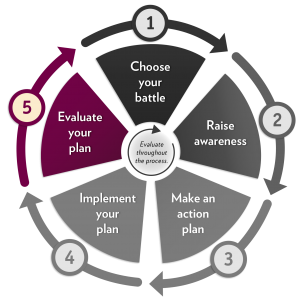 Evaluation should occur throughout the entire project as well as at the end. Individual and group reflection, especially in a youth participatory action research project, provide the youth with opportunities to look back on their recent experience. It helps them think about their contributions, what they learned, and how they want to move forward. Take time to use the various forms of evaluation throughout the Five Steps of Action and celebrate accomplishments and milestones. Use this section as needed throughout each of the other parts of the process.
Evaluation should occur throughout the entire project as well as at the end. Individual and group reflection, especially in a youth participatory action research project, provide the youth with opportunities to look back on their recent experience. It helps them think about their contributions, what they learned, and how they want to move forward. Take time to use the various forms of evaluation throughout the Five Steps of Action and celebrate accomplishments and milestones. Use this section as needed throughout each of the other parts of the process.
Watch the video below for a short overview of Evaluate Your Plan.
In the Guidebook, facilitators will find the following:
- A list of the crucial questions youth will need answers to before they are finished evaluating their plan
- Foundations of evaluation and how different evaluation methods can be used throughout the youths’ project
- How to choose an evaluation method and plan for conducting evaluation
- Strategies for when and how to facilitate personal reflection as well as question prompts to use
- Reminders and suggestions for celebration
- And an evaluation checkpoint, which allows youth to be sure they are ready to move on and reminds them to reflect and celebrate their accomplishments
Click the image at the right to download the Guidebook. ![]()
Supplemental Resources ![]()
The supplemental resources below support the downloadable Guidebook and are not intended to be used alone.
Handouts
Evaluation Method Cards
Guidebook Activity: Evaluation Methods (pages 66 and 68)
Cards describing evaluation methods and when to use them, examples of the method and advantages and disadvantages of the methods.
Evaluation Planning Handout (Word Document)
Guidebook Activity: Planning for Formal Evaluation (Page 68)
A fillable handout to help walk you through planning your evaluation.
Evaluate Your Plan—Self-Assessment
Don’t forget to reflect and evaluate before you move on.
Evaluation Method How-to-Guides
Surveys
A how-to guide on developing surveys to quickly gather information, a list of survey tools, and a survey checklist.
Interviews
A how-to-guide on developing questions and conducting interviews with community members.
Tracking
A how-to-guide on simple tracking, tracking to understand how often something happens over a specific period of time, and participatory tracking, tracking that involves key stakeholders in monitoring what happens over a period of time.
Observation
A how-to-guide on observing and documenting evidence of a need or effort.
Creative
A how-to-guide on using a creative method to collect visual data form individuals who may not have the words to share their feelings, learning, or experiences.
Ripple Mapping
A how-to guide on ripple mapping to understand the impact of the project throughout the different aspects of the community.
Case Study Cards
Use these Case Study Cards for Guidebook Activity: Planning for Formal Evaluation (page 68)
Additional Resources
Youth Leading Community Change: An Evaluation Toolkit
The Youth Leading Community Change: An Evaluation Toolkit includes activities and resources to measure the impact of youth-led community projects. Supported by resources from the Girl Scouts of the USA, the National 4-H Council, the National NIFA Organization, and Evaluation Access.



